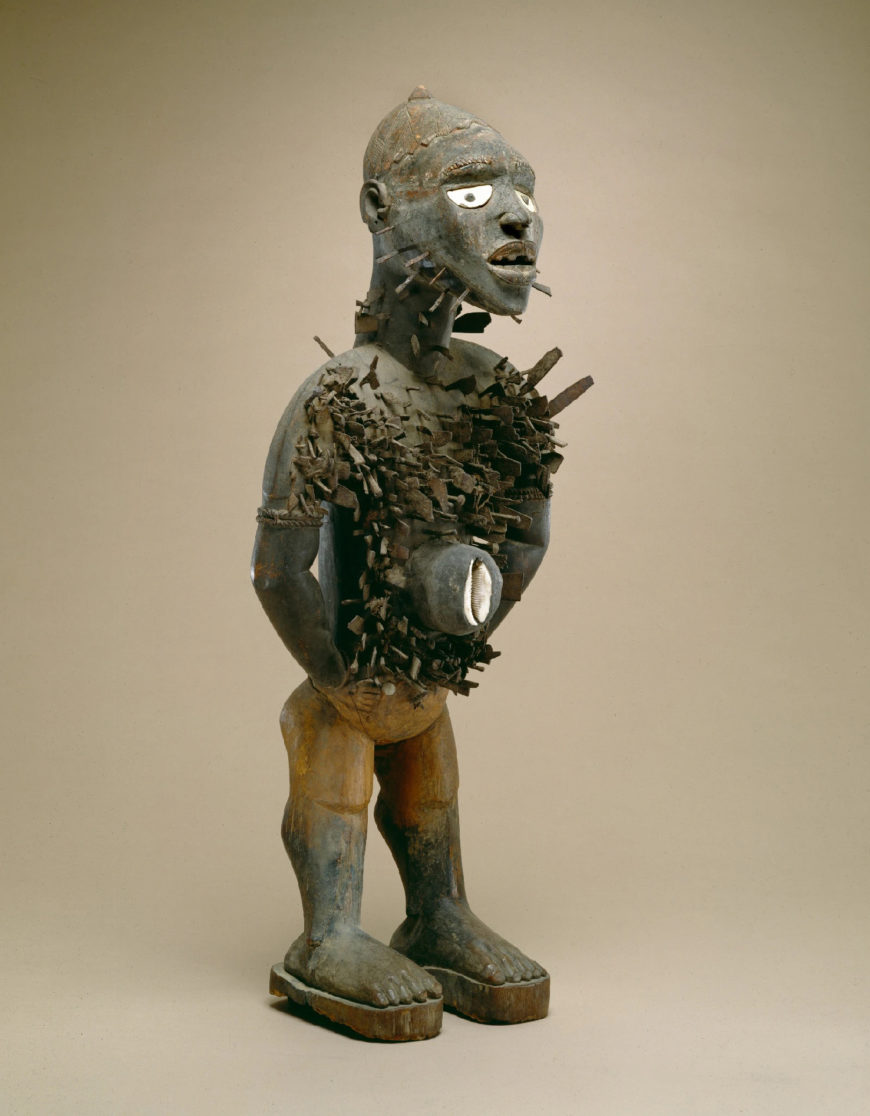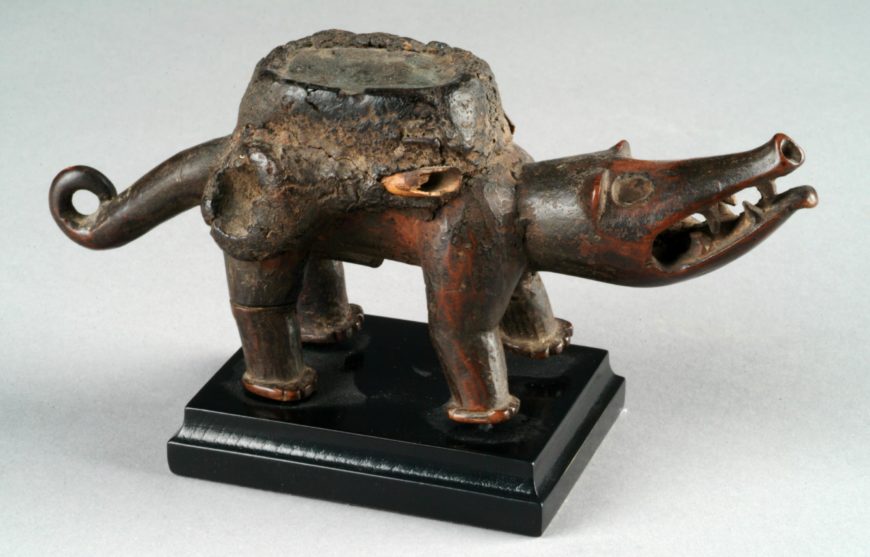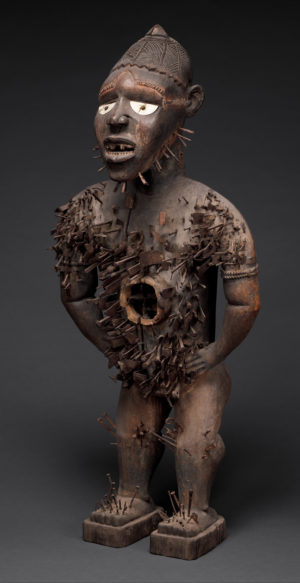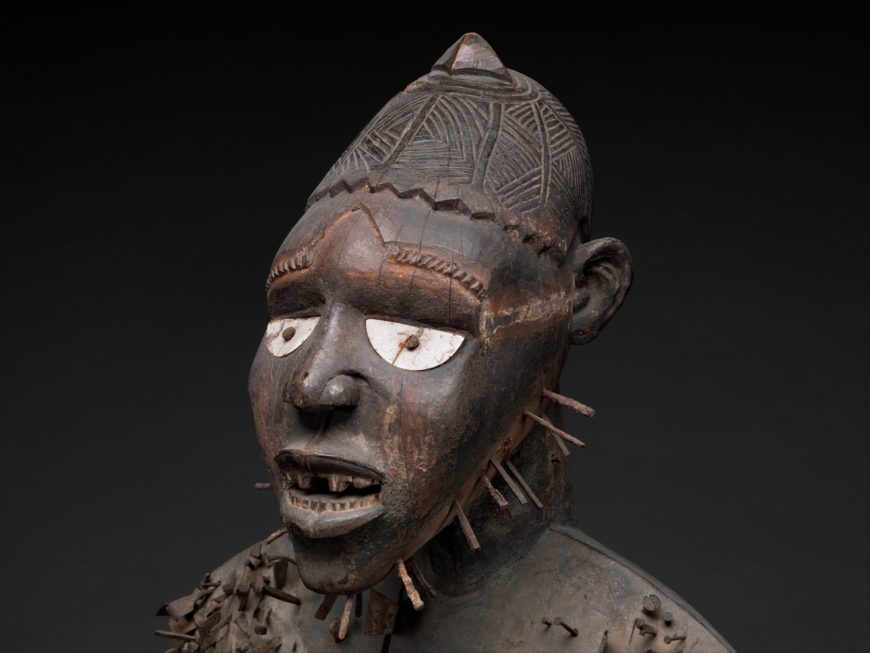These fascinating spiritual figures became prime targets for the ire of Christian missionaries in the 19th century.
Power Figure: Male (Nkisi), 19th-mid 20th century, Kongo peoples, wood, pigment, nails, cloth, beads, shells, arrows, leather, nuts, and twine, 58.8 x 26 x 25.4 cm (The Metropolitan Museum of Art). Speakers: Dr. Peri Klemm and Dr. Beth Harris
[0:00] [music]
Dr. Peri Klemm: [0:05] We’re at the Metropolitan Museum of Art, and we’re looking at a Kongo nkisi figure from the Democratic Republic of Congo.
Dr. Beth Harris: [0:13] The Kongo is in Central Africa. It was a large kingdom that was founded in the 14th century, and over the centuries, eventually colonized by Belgium. When the Portuguese, who arrived in Africa in the late 15th century, saw these figures, nkisi, and also brought missionaries to Christianize the people of the Kongo, they asked that these figures be burned.
Dr. Klemm: [0:37] The term “nkisi” refers to a spirit, but more specifically [to] medicine. When I say medicine, I don’t mean an aspirin, I mean the herbs and supplements that a healer would use to help someone on a physical, but also on a spiritual, mental, and emotional level. The nganga is the ritual specialist among the Kongo in this period of time, around the 19th century, who would use nkisi figures to help his clients.
Dr. Harris: [1:03] The nganga would ask a sculptor to carve this, and then the nganga would use it over the course of a considerable amount of time, and over that time, this figure would accrue everything that we see on it. All of this material is covering its abdomen, where likely, although we can’t see it, is a case for holding that spiritual medicine.
Dr. Klemm: [1:28] That spiritual center, the mooyo, the belly, is where you place the medicine or the materials, and it could be stone, it could be herbs, it could be pastes and clays. The nganga would be mixing this formula together, placing it in the cavity in the belly, and then covering it up so that it’s completely sealed.
Dr. Harris: [1:48] The nganga would use this figure in several different ways. He could use it to heal a client who came to him, but he could also use it to record agreements and contracts, and also could activate it to go after evildoers.
Dr. Klemm: [2:03] As a witness, the nkisi really is there to honor contracts and agreements and oaths that are taken, and the nganga might take a strip of cloth and literally tie and bind that agreement together.
Dr. Harris: [2:16] Each one of those knots that we’re seeing is likely that.
Dr. Klemm: [2:20] In order for the nkisi to do your bidding — that is, to go after someone who broke an oath or did you wrong — you might use dog’s teeth or elements of birds.
Dr. Harris: [2:30] We see a sharp object that looks like it belonged to an animal, a bird, a dog, that could do harm.
Dr. Klemm: [2:37] In order to activate this nkisi — because, really, it’s just a piece of wood until it’s activated with a spirit — the nganga would hammer nails into its skin, thereby calling attention to the nkisi to come and do its bidding.
Dr. Harris: [2:52] There are so many nails. It feels like this was used over decades.
Dr. Klemm: [2:55] It constantly looks different as the nganga works. While we see it here encrusted, and crumbling, and full of lots of materials, what it’s probably missing is the medicine that was in its abdomen originally.
[3:09] Because it’s said that the medicine pouch is so central and so potent, you would not sell this piece or let it fall into the hands of anyone but the nganga with that present.
Dr. Harris: [3:21] Likely, it originally had legs, was able to stand, had a base. Those are not here. It’s impossible to know exactly what those looked like. The figure is encrusted on all of its sides. There’s another example here at the Met where we can see more clearly the opening in the abdomen.
Dr. Klemm: [3:39] We notice that that abdomen is hollow. Whatever was inside of it has been taken out, rendering it impotent.
Dr. Harris: [3:45] We also see amulets. One of them is beaded. Another looks almost like a nut that’s got some carving on the outside.
Dr. Klemm: [3:53] Seed pods, pieces of animal, carved figures. The carved figures actually have something inside of their bellies.
Dr. Harris: [4:00] We seem to have two interlocking crocodiles.
Dr. Klemm: [4:03] We also have a bell on the side, which is similar to the nails in that it can be rung to bring the nkisi spirit into this figure. The nkisi would have been housed in the nganga’s home, in his shrine.
Dr. Harris: [4:16] If I was a client, I would bring money or something to trade to the nganga, who would do this work for me, either mark a contract or an agreement of some kind, or right some sort of wrong for me.
Dr. Klemm: [4:29] The nganga also has to remember what each one of these nails and knots were for. The nkisi then becomes a wonderful historic social document of a group of people who sought out help from their ritual specialist.
[4:46] [music]

Power figure (nkisi nkondi), Kongo peoples, c. late 19th century, wood and metal, 115.6 x 47 x 38.1 cm, Democratic Republic of the Congo (Detroit Institute of Arts)
Divine protection
Sacred medicines and divine protection are central to the belief of the Kongo peoples (Democratic Republic of Congo). The Kongo believe that the great god, Ne Kongo, brought the first sacred medicine (or nkisi) down from heaven in an earthenware vessel set upon three stones or termite mounds.
A nkisi (plural: minkisi) is loosely translated as a “spirit,” yet it is represented as a container of sacred substances which are activated by supernatural forces that can be summoned into the physical world. Visually, these minkisi can be as simple as pottery or vessels containing medicinal herbs and other elements determined to be beneficial in curing physical illness or alleviating social ills. In other instances, minkisi can be represented as small bundles, shells, and carved wooden figures. Minkisi represent the ability to both ‘contain’ and ‘release’ spiritual forces, which can have both positive and negative consequences on the community.
Nkisi nkondi
A fascinating example of a nkisi can be found in a power figure called nkisi nkondi. A nkisi nkondi can act as an oath taking image which is used to resolve verbal disputes or lawsuits (mambu) as well as an avenger (the term nkondi means ‘hunter’) or guardian if sorcery or any form of evil has been committed.

Power Figure (nkisi kozo), Kongo peoples, c. 19th century, wood, mirrors, resin, tukula powder, and medicinal substances, 7 x 17.5 x 7 cm, Democratic Republic of the Congo (University of Michigan Museum of Art)
These minkisi are wooden figures representing a human or animal, such as a dog (nkisi kozo) carved under the divine authority and in consultation with an nganga or spiritual specialist who activates these figures through chants, prayers, and the preparation of sacred substances which are aimed at ‘curing’ physical, social or spiritual ailments.

Power Figure (Nkisi N’Kondi: Mangaaka), Kongo peoples, mid to late nineteenth century, wood, paint, metal, resin, ceramic, 118 x 49.5 x 39.4 cm, Democratic Republic of Congo (The Metropolitan Museum of Art)
Insertions
Nkisi nkondi figures are highly recognizable through an accumulation of pegs, blades, nails, or other sharp objects inserted into its surface. Medicinal combinations called bilongo are sometimes stored in the head of the figure but frequently in the belly of the figure, which is shielded by a piece of glass, mirror, or other reflective surface. The glass represents the ‘other world’ inhabited by the spirits of the dead, who can peer through and see potential enemies. Elements with a variety of purposes are contained within the bilongo. Seeds may be inserted to tell a spirit to replicate itself; mpemba or white soil deposits found near cemeteries represent and enlist support from the spiritual realm. Claws may incite the spirits to grasp something, while stones may activate the spirits to pelt enemies or protect one from being pelted.
The insertions are driven into the figure by the nganga and represent the mambu and the type or degree of severity of an issue can be suggested through the material itself. A peg may refer to a matter being ‘settled’ whereas a nail, deeply inserted, may represent a more serious offense such as murder. Prior to insertion, opposing parties or clients often lick the blades or nails, to seal the function or purpose of the nkisi through their saliva. If an oath is broken by one of the parties or evil befalls one of them, the nkisi nkondi will become activated to carry out its mission of destruction or divine protection.

Face (detail), Power Figure (Nkisi N’Kondi: Mangaaka), Kongo peoples, mid to late nineteenth century, wood, paint, metal, resin, ceramic, 118 x 49.5 x 39.4 cm, Democratic Republic of Congo (The Metropolitan Museum of Art)
Migrations
Europeans may have encountered these objects during expeditions to the Congo as early as the 15th century. However, several of these “fetish” objects, as they were often termed, were confiscated by missionaries in the late 19th century and were destroyed as evidence of sorcery or heathenism. Nevertheless, several were collected as objects of fascination and even as an object of study of Kongo culture. Kongo traditions such as those of the nkisi nkondi have survived over the centuries and migrated to the Americas and the Caribbean via Afro-Atlantic religious practices such as vodun, Palo Monte, and macumba. In Hollywood, these figures have morphed into objects of superstition, such as New Orleans voodoo dolls covered with stick pins. Nonetheless, minkisi have left an indelible imprint as visually provocative figures of spiritual importance and protection.

